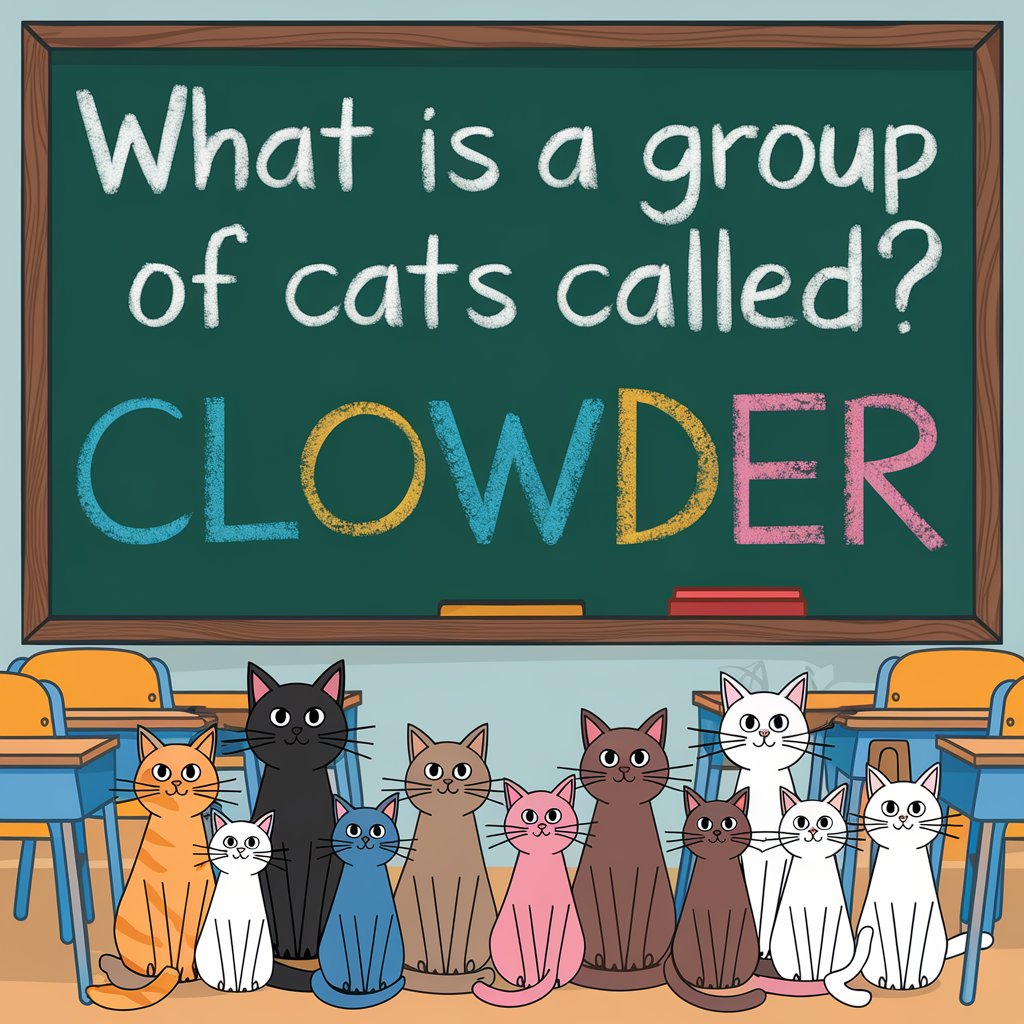What Is a Group of Cats Called?
Cats are fascinating creatures, beloved by many for their playful nature and mysterious behavior. While it’s common to see a cat lounging in the sun or chasing after a toy, have you ever wondered what a group of these furry friends is called? Whether you’re a seasoned cat owner or just someone curious about feline terminology, understanding the name of a group of cats can be both fun and informative. what is a group of cats called? Let’s dive into the details!
The Terminology: What Is a Group of Cats Called?
When it comes to groups of animals, each species often has its unique term. For example, a group of wolves is called a “pack,” and a group of birds is known as a “flock.” But what is a group of cats called? The most common term used for a group of cats is “clowder.” Yes, you read that right—a clowder! This word is not only fun to say but also has a rich history that dates back to the early days of the English language.
In addition to clowder, there are other terms used to describe a group of cats. For example, a group of kittens is often referred to as a “kindle” or “litter,” especially when they are from the same mother. But when it comes to adult cats, clowder remains the most widely accepted term.
Why Is It Called a Clowder?

Now that you know what a group of cats is called, you might be wondering why this term is used. The word “clowder” is believed to have originated from the Middle English word “clodder,” which means “clot” or “clump.” This makes sense when you think about how cats often huddle together in groups, forming a close-knit, clumped-up gathering. Over time, the word evolved into “clowder,” and it has been used to describe a group of cats ever since.
Interestingly, the term clowder is not as commonly known as other animal group names. This could be because cats are often seen as solitary animals, so the concept of them gathering in groups is not as prevalent in popular culture. However, anyone who has spent time around cats knows that they can be quite social, especially when it comes to forming bonds with other cats.
Other Terms for a Group of Cats
While clowder is the most widely recognized term, there are a few other words that can be used to describe a group of cats. what is a group of cats called? These terms are less common but are still interesting to know:
- Cluster: This term is sometimes used interchangeably with clowder, though it is less specific to cats and can refer to a group of other animals or objects as well.
- Glaring: Glaring is another term that can be used for a group of cats, particularly when they are seen as unfriendly or hostile. This word evokes the image of cats staring intently, which they are known to do!
- Pounce: This playful term is sometimes used to describe a group of cats, especially when they are in a playful mood. It captures the essence of a cat’s natural hunting behavior.
- Down: This is an older, less common term that was once used to describe a group of cats. It has fallen out of use but can still be found in some historical texts.
Each of these terms offers a unique way to describe a group of cats, but clowder remains the most widely recognized and used term.
The Social Behavior of Cats in a Clowder

Understanding what a group of cats is called leads to a deeper question: how do cats behave when they are in a group? While domestic cats are often thought of as solitary animals, they can be quite social, especially in certain environments.
In a clowder, cats may establish a hierarchy, with one cat typically taking on the role of the dominant or “alpha” cat. This cat may assert its dominance through body language, vocalizations, and even physical interactions. The other cats in the clowder will generally respect this hierarchy, though challenges for dominance can occur.
Cats in a clowder will often groom each other, which is a behavior known as “allogrooming.” This not only helps to keep their fur clean but also strengthens social bonds between the cats. You may also notice cats in a clowder rubbing against each other or sleeping nearby. These behaviors are all part of the social dynamics within the group.
Related Article: Can I Put Coconut Oil on My Cats Bum?
How to Manage a Clowder of Cats at Home

If you have multiple cats at home, you are essentially the caretaker of a clowder! Managing a group of cats requires understanding their social dynamics and providing an environment where all the cats can thrive.
Here are some tips for managing a clowder of cats:
- Provide Enough Resources: Ensure that there are enough food and water bowls, litter boxes, and sleeping spots for each cat. This can help reduce competition and stress within the clowder.
- Respect Their Space: Cats are territorial animals, so it’s important to provide enough space for each cat to have its territory. This can be achieved by creating vertical spaces (such as cat trees) and providing hiding spots.
- Monitor Their Behavior: Keep an eye on the interactions between your cats. If you notice any signs of aggression or tension, such as hissing, swatting, or staring, it may be necessary to intervene or seek advice from a veterinarian or animal behaviorist.
- Encourage Positive Interactions: Encourage your cats to engage in positive interactions, such as playing together or grooming each other. This can help strengthen the social bonds within the clowder.
- Consider Their Personalities: Not all cats are naturally social, so it’s important to consider the individual personalities of your cats when managing a clowder. Some cats may prefer to be more solitary, while others may enjoy the company of their feline companions.
The Importance of Understanding What a Group of Cats Is Called
Knowing what a group of cats is called might seem like a small detail, but it can enhance your understanding and appreciation of these amazing animals. Whether you’re a cat owner, a pet enthusiast, or simply curious about animal terminology, understanding the term clowder can give you insight into the social behavior and dynamics of cats.
Furthermore, understanding what a group of cats is called can also help in various practical situations. For example, if you’re working in an animal shelter, veterinary clinic, or even volunteering with a cat rescue organization, knowing the correct terminology can improve communication and make your work more effective.
Fun Facts About Clowders
To wrap up this article, let’s explore some fun and interesting facts about clowders:
- Clowder Communication: Cats in a clowder use a combination of vocalizations, body language, and scent markings to communicate with each other. This communication helps to maintain social order and prevent conflicts.
- Feral Cat Colonies: Feral cats often live in clowders, forming colonies that are typically centered around a food source. These colonies are often matriarchal, with related females and their offspring forming the core of the group.
- Big Cat Clowders: While the term clowder is usually associated with domestic cats, it can also apply to big cats such as lions. A group of lions is more commonly referred to as a “pride,” but in casual conversation, clowder can still be used to describe them.
- Historical References: The term clowder has been used in literature and historical texts for centuries. It’s a word with a rich history that connects us to the long-standing relationship between humans and cats.
- Cats in Culture: Cats have been featured in various cultures and mythologies around the world, often depicted in groups or as solitary hunters. Understanding what a group of cats is called can provide additional context when exploring these cultural references.

Conclusion
What is a group of cats called? The answer is a clowder! This term may not be as widely recognized as other animal group names, but it carries with it a rich history and a deeper understanding of feline social behavior. Whether you have a clowder of your own at home or are simply fascinated by cats, knowing this term adds a new layer of appreciation for these incredible animals. So the next time you see a group of cats, you can proudly say, “That’s a clowder!”
FAQs: What Is a Group Of Cats Called?
- What do you call a group of cats?
A group of cats is called a clowder or glaring. - Is a group of cats called a pride?
No, a group of cats is not called a pride; a pride refers to a group of lions. - What is a group of kittens called?
A group of kittens is called a kindle or litter. - What is a fleet of cats called?
There isn’t a specific term for a fleet of cats. “Fleet” generally refers to a group of ships, not cats.

Welcome to Hypocats.com! I’m Khawar Akhtar, a passionate writer dedicated to all things feline. With a deep love for cats and a keen interest in their health, diet, and training, I strive to provide cat owners with valuable insights and practical advice to enhance their furry friends’ well-being. My goal is to share my expertise and enthusiasm for our whiskered companions, helping them lead happier, healthier lives. When I’m not writing, you’ll find me spending quality time with my Russian Blue cat, enjoying the simple joys that come with being a cat lover. Thank you for visiting Hypocats.com—I hope you find the information here as helpful and inspiring as I do!



Leave a Reply